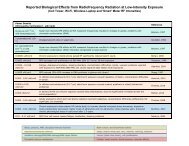Evidence for Effects on Neurology and Behavior - BioInitiative Report
Evidence for Effects on Neurology and Behavior - BioInitiative Report
Evidence for Effects on Neurology and Behavior - BioInitiative Report
You also want an ePaper? Increase the reach of your titles
YUMPU automatically turns print PDFs into web optimized ePapers that Google loves.
outcome of the biological effects of RFR. A series of studies by Frei et al. [1989a,b] also<br />
dem<strong>on</strong>strated some interesting results <strong>on</strong> this issue. The effects of high intensity 2450- <strong>and</strong> 2800-<br />
MHz RFRs <strong>on</strong> heart rate, blood pressure, <strong>and</strong> respiratory rate in ketamine-anesthetized rats were<br />
studied. Both frequencies produced increases in heart rate <strong>and</strong> blood pressure <strong>and</strong> no significant<br />
difference was observed whether c<strong>on</strong>tinuous-wave or pulsed radiati<strong>on</strong> was used. A difference<br />
was observed, however, when the animals were exposed with their bodies parallel to the H- or E-<br />
field. In the case of 2450-MHz RFR, the E-orientati<strong>on</strong> exposure produced greater increases in<br />
heart rate <strong>and</strong> blood pressure than the H-orientati<strong>on</strong> exposure; whereas no significant difference<br />
in the effects between the two exposure orientati<strong>on</strong>s was observed with the 2800-MHz radiati<strong>on</strong>.<br />
The authors speculated that the differences could be attributed to the higher subcutaneous<br />
temperature <strong>and</strong> faster rise in col<strong>on</strong>ic temperature in the E-orientati<strong>on</strong> when the rats were<br />
exposed at 2450 MHz than at 2800 MHz. Once again, this points out that subtle differences in<br />
exposure parameters could lead to different resp<strong>on</strong>ses. There<str<strong>on</strong>g>for</str<strong>on</strong>g>e, due to the peculiar pattern of<br />
energy depositi<strong>on</strong> <strong>and</strong> heating by RFR, it may be impossible to replicate the thermal effect of<br />
RFR by general heating, i.e., use of temperature c<strong>on</strong>trols.<br />
The fact that dosimetry data were based <strong>on</strong> stati<strong>on</strong>ary models that usually show discrete<br />
patterns of energy absorpti<strong>on</strong>, further complicate the matter. In animal studies, unless the animal<br />
is restrained, the energy absorpti<strong>on</strong> pattern changes during the exposure period depending <strong>on</strong> the<br />
positi<strong>on</strong> <strong>and</strong> the orientati<strong>on</strong> of the animal. A possible soluti<strong>on</strong> would be to per<str<strong>on</strong>g>for</str<strong>on</strong>g>m l<strong>on</strong>g-term<br />
exposure experiments, thus, the absorpti<strong>on</strong> pattern <strong>on</strong> the average would be made more uni<str<strong>on</strong>g>for</str<strong>on</strong>g>m.<br />
Another important c<strong>on</strong>siderati<strong>on</strong> regarding the biological effects of RFR is the durati<strong>on</strong> or<br />
number of exposure episodes. This is dem<strong>on</strong>strated by the results of some of the studies <strong>on</strong> the<br />
neurological effects of RFR. Depending <strong>on</strong> the resp<strong>on</strong>ses studied in the experiments, several<br />
outcomes could result: an effect was observed <strong>on</strong>ly after prol<strong>on</strong>ged (or repeated) exposure, but<br />
not after acute exposure [Baranski, 1972; Baranski <strong>and</strong> Edelwejn, 1968, 1974; Mitchell et al.,<br />
1977; Takashima et al., 1979], an effect disappeared after prol<strong>on</strong>ged exposure suggesting<br />
habituati<strong>on</strong> [Johns<strong>on</strong> et al., 1983; Lai et al., 1987c, 1992a], <strong>and</strong> different effects were observed<br />
after different durati<strong>on</strong>s of exposure [Baranski, 1972; Dumanski <strong>and</strong> Sh<strong>and</strong>ala, 1974; Grin, 1974;<br />
Lai et al., 1989a, 1989b; Servantie et al., 1974; Snyder, 1971]. All of these different resp<strong>on</strong>ses<br />
reported can be explained as being due to the different characteristics of the dependent variable<br />
studied. An interesting questi<strong>on</strong> related to this is whether or not intensity <strong>and</strong> durati<strong>on</strong> of<br />
exposure interact, e.g., can exposure to a low intensity over a l<strong>on</strong>g durati<strong>on</strong> produce the same<br />
effect as exposure to a high intensity radiati<strong>on</strong> <str<strong>on</strong>g>for</str<strong>on</strong>g> a shorter period?<br />
Thus, even though the pattern or durati<strong>on</strong> of RFR exposure is well-defined, the resp<strong>on</strong>se of<br />
the biological system studied will still be unpredictable if we lack sufficient knowledge of the<br />
resp<strong>on</strong>se system. In most experiments <strong>on</strong> the neurological effects of RFR, the underlying<br />
mechanism of the dependent variable was not fully understood. The purpose of most of the<br />
studies was to identify <strong>and</strong> characterize possible effects of RFR rather than the underlying<br />
mechanisms resp<strong>on</strong>sible <str<strong>on</strong>g>for</str<strong>on</strong>g> the effects. This lack of knowledge of the resp<strong>on</strong>se system studied is<br />
not uncomm<strong>on</strong> in biological research. In this regard, it may be appropriate to compare the<br />
biological <strong>and</strong> neurological effects of RFR with those of ethanol. Both entities exert n<strong>on</strong>-specific<br />
effects <strong>on</strong> multiple organs in the body. Their effects are n<strong>on</strong>specific, because both ethanol <strong>and</strong><br />
RFR are not acting <strong>on</strong> specific receptors. The biological effects of ethanol could be a general<br />
acti<strong>on</strong> <strong>on</strong> cell membrane fluidity.<br />
In reviewing the literature <strong>on</strong> the neurological effects of ethanol, <strong>on</strong>e notices some<br />
similarity with those of RFR. In both cases, a wide variety of neurological processes were<br />
63



